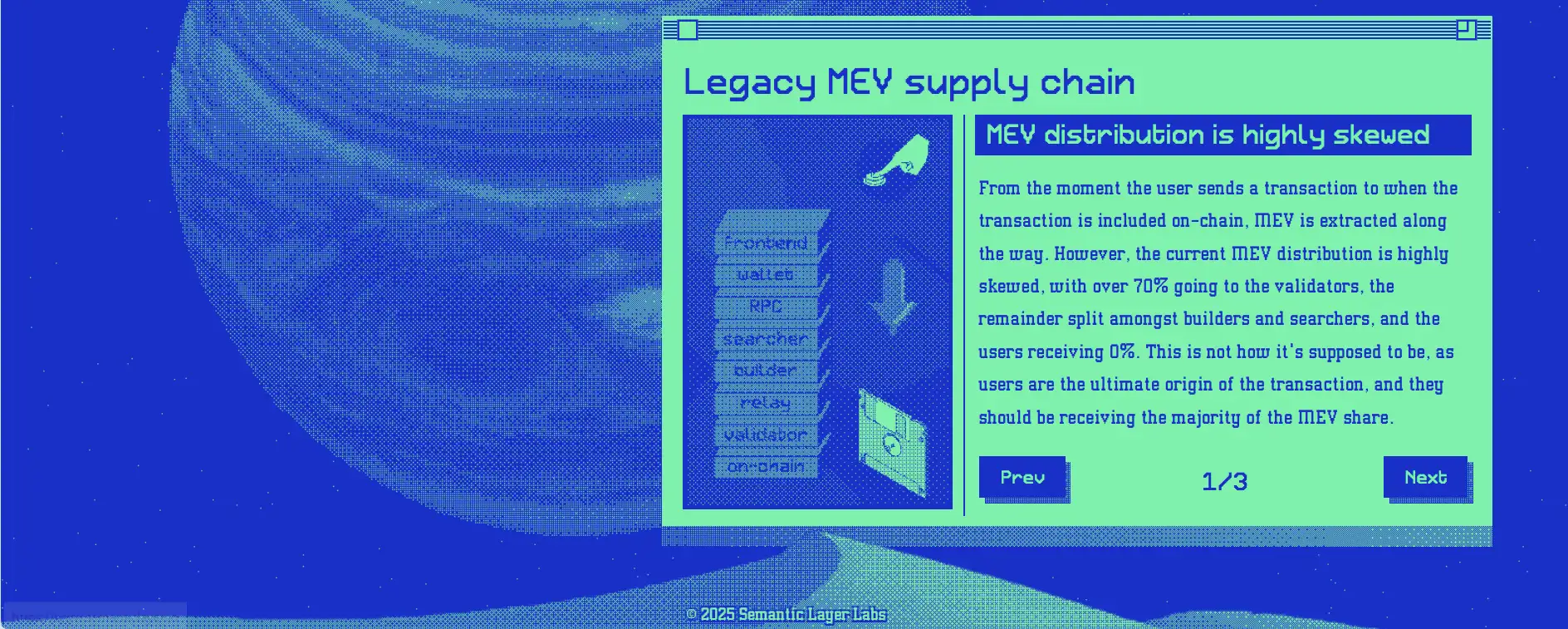About Semantic Layer
Semantic Layer is redefining the way dApps interact with MEV by empowering protocols with full control over sequencing and incentive distribution. Designed as a programmable meta-transaction layer, Semantic Layer gives decentralized applications the tools to internalize MEV, customize their execution flow, and build user-first economic structures.
By allowing developers to define how transactions are ordered and how value is shared, Semantic Layer eliminates the zero-sum MEV extraction model and creates a more sustainable environment for both users and builders. The project’s mission is to restore economic dignity to those generating transaction value—the users—and build better-aligned decentralized markets from the base layer up.
Semantic Layer addresses one of the most pressing problems in modern blockchain architecture: the misalignment of incentives in the MEV (Maximal Extractable Value) supply chain. In traditional chains, MEV generated by user activity is captured primarily by validators and builders—with users receiving no compensation despite originating the transaction value. This imbalance creates a distorted and extractive system that degrades trust in DeFi and undermines user experience.
Semantic Layer changes that by introducing application-specific sequencing and a programmable meta-transaction layer that enables dApps to take control of their own execution logic. Instead of relying on generic sequencing handled by the base layer (like Ethereum or Solana), Semantic Layer allows each dApp to define how transactions are ordered, how MEV is distributed, and how security is enforced—on a per-protocol basis.
The result is a new paradigm where developers and users become the primary beneficiaries of the value they generate. This is achieved through the implementation of a Smart Meta Transaction Standard—a programmable interface that allows dApps to design custom MEV workflows, enforce fairness, and even implement proactive security measures like pre-trade validation, context-sensitive ordering, and fine-grained access control. These tools give rise to what Semantic calls “sequencing sovereignty”, empowering every protocol to shape its own economic rules.
The project is also incubating ecosystem initiatives like Grug Bay, which explores meta-sequencing for scarce digital resources through on-chain AI agents. This represents Semantic Layer’s broader vision: enabling a more autonomous, application-centric form of blockchain capitalism, where agents, applications, and assets operate with purpose-built sequencing logic rather than one-size-fits-all ordering.
Backed by prominent investors such as Figment Capital, Hack VC, Bankless Ventures, Robot Ventures, and Anagram, Semantic Layer is building the foundational infrastructure for a new class of dApps that are not only more performant, but economically just. It positions itself alongside—and arguably ahead of—MEV-conscious systems like Flashbots SUAVE (flashbots.net) and Espresso Systems (espressosys.com), by going beyond block-level ordering to per-dApp sequencing.
Ultimately, Semantic Layer provides the tools to turn MEV into a protocol-native primitive—one that strengthens applications instead of undermining them. By enabling aligned incentives, internalized execution, and composable sequencing logic, it gives builders a way to make dApps great again—secure, performant, and user-centered.
Semantic Layer introduces a powerful set of features and incentive-alignment tools for decentralized application developers:
- Programmable MEV Supply Chain: dApps can define how MEV is routed, who receives it, and under what conditions—enabling user and developer-centric designs.
- Application-Specific Sequencing: Move beyond base-layer sequencing by customizing transaction order and validation logic at the application level.
- Smart Meta Transaction Standard: A programmable transaction format that lets developers include rules, preconditions, and reward logic inside each meta-transaction.
- MEV Internalization: Instead of allowing validators to capture all MEV, protocols using Semantic Layer can redirect it to users, DAOs, or developers.
- Enhanced Security: Reduce front-running, sandwich attacks, and value leakage with context-aware execution, proactive validation, and enforceable constraints.
- Ecosystem Composability: Semantic Layer is chain-agnostic and can be deployed on any EVM-compatible chain or execution layer.
- AI-Driven Meta-Sequencing: Projects like Grug Bay explore intelligent resource sequencing using on-chain AI agents.
Semantic Layer is designed for developers looking to bring fairness, efficiency, and sovereignty into their dApps. Here’s how to begin with Semantic Layer:
- Step 1 – Learn the Architecture: Read the official blog and documentation to understand Smart Meta Transactions and how programmable sequencing works.
- Step 2 – Explore Use Cases: Review example implementations that show how Semantic Layer supports MEV redirection, user rebates, or priority transaction logic.
- Step 3 – Join the Developer Community: Connect with the team on Discord and follow updates via X.
- Step 4 – Integrate the Standard: Use Semantic Layer’s tools and SDKs (coming soon) to start building with programmable MEV and transaction control.
- Step 5 – Apply Sequencing Logic: Embed application-specific sequencing directly into your smart contracts, enabling decentralized control over execution.
- Step 6 – Monitor and Evolve: Continue updating your logic with ecosystem signals, on-chain AI inputs, or community governance to adapt your sequencing strategy.
Semantic Layer FAQ
Semantic Layer introduces a programmable meta-transaction layer that lets dApps decide how MEV (Maximal Extractable Value) is distributed. Through its Smart Meta Transaction Standard, protocols can embed rules into each transaction that define who gets what share of the MEV generated—whether it’s the user, the app team, or a DAO. This transforms MEV from an extractive validator bonus into a programmable economic primitive that benefits the community. It allows builders on Semantic Layer to realign incentives and retain value inside their own ecosystems.
Sequencing sovereignty means that a dApp controls the order in which its transactions are executed. This matters because in most blockchains, base-layer validators determine transaction ordering—leading to issues like front-running, sandwiching, and unfair execution. Semantic Layer enables each application to define its own transaction sequencing logic, allowing for fairer execution, MEV internalization, and use-case-specific behaviors. With Semantic Layer, developers can code-in economic and security policies that would otherwise be dictated by chain-level infrastructure.
Semantic Layer protects users by giving developers tools to enforce context-aware transaction ordering. This includes rejecting suspicious pre- or post-trade behaviors, setting constraints within meta-transactions, and using programmable sequencing to avoid harmful MEV exploitation. Applications can flag or penalize toxic behavior directly in the execution path. By shifting control from miners and validators to dApps, Semantic Layer drastically reduces the surface area for predatory tactics that degrade user experience.
Unlike Flashbots or other block-level MEV relayers, Semantic Layer brings MEV programmability inside the application layer. Rather than submitting bundles to centralized builders, dApps using Semantic Layer embed their own logic directly into meta-transactions. This allows for real-time enforcement of rules, granular MEV splits, and sequencing logic tailored to the specific needs of a protocol. Semantic Layer enables internalized MEV for any dApp on any chain—without reliance on external actors to act fairly.
Any application that handles high-value user interactions or is vulnerable to transaction reordering attacks stands to benefit. This includes DEXs, lending markets, liquid staking protocols, and on-chain games. These dApps can use Semantic Layer to design their own MEV flows, prevent frontrunning, or reward users directly for the value their transactions generate. Because Semantic Layer is chain-agnostic, it can be implemented across multiple EVM-compatible ecosystems where MEV behavior impacts execution quality.
You Might Also Like












